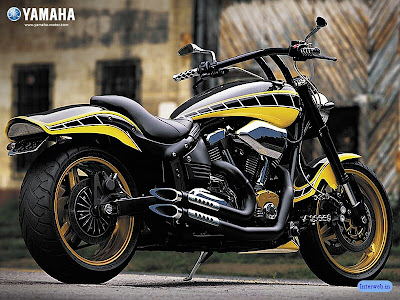2011 CBR250R Engine The 2011 Honda CBR250R motorcycle engine development took shape by aiming at a global single-cylinder design; a next-generation four-stroke liquid-cooled powerplant that would deliver torquey performance not only at low engine speeds but also in the high-rpm range, while still being smooth-running beginners motorcycle.
Being a global motorcycle, the 250cc economical operation in terms of fuel efficiency and simple servicing was also a stated Honda characteristic. In addition, Honda wanted the lightweight CBR250R engine to be compact dimensions would set the stage for beginning motorcycle rider handling characteristics.
Honda selected a dual overhead camshaft layout as the valve actuation system. The DOHC designs improve combustion efficiency by reducing the weight of the reciprocating portion of the valves.
This design also allowed Honda motorcycle engineers freedom in choosing the included valve angle, the port shape, and the shape of the combustion chamber. In addition, the choice of a DOHC configuration contributed to improved product appeal as a CBR sportbike.
The 2011 CBR250R valve train, has a roller rocker arm that was adopted in combination with the DOHC engine configuration, a-world-first application that has been patented by Honda. This unique combination produces a low-friction valve train with a smaller cylinder head and an ultra-compact layout for the roller rocker arm.
The choice of a shim design for valve tappet adjustment reduced the rocker arm weight, while internal engine friction was further reduced by setting the valve spring load to a low level. For ease of maintenance and reduced operating costs, the CBR250R valve shims can be replaced for valve adjustment maintenance without removing the camshafts.
This Honda CBR 250 R design also allowed the engineers the freedom to incorporate a pent-roof combustion chamber with a narrow included valve angle for enhanced combustion characteristics.
To reduce the flow of blow-by gasses and minimize oil consumption, a spiny sleeve design was adopted for the Honda cylinder sleeve. Small spines have been added to the outer surface of the cylinder sleeve to improve CBR250R cooling performance and help reduce distortion of the cylinder inner shape.
In addition, centrifugal casting allows a thin, uniform wall thickness, which helps reduce the weight of the motorcycle. For emissions reductions, an O2 sensor is combined with the built-in air injection (AI) system, and a catalyzer is fitted inside the exhaust pipe to comply with emissions standards.
To enhance motorcycle engine performance, a very over-square, short-stroke 250cc engine (bore x stroke: 76mm x 55mm) was chosen to improve responsiveness. The resulting bore and stroke are commensurate to those of the CBR 1000 RR, Honda's superbike.
The 30mm intake valves are a mere half-millimeter smaller in diameter than those used in the CBR1000RR, while the 24mm diameters of the exhaust valves match exactly between the two bikes.
To reduce reciprocating weight and friction, the Honda CBR250R piston carries a very short skirt and features a slick molybdenum coating. Friction was further reduced by creating light striations on the piston to facilitate retention of lubricating engine oil, lowering the tension of the piston rings, and applying a smooth, shot-peen-hardened finish to the piston pin.
Another slick bit of Honda CBR250R design work further reduces engine friction: The cylinder centerline is offset from the center of the crankshaft 4mm toward the exhaust side. Doing so reduces the lateral resistance generated between the piston and the cylinder during the power stroke. It's a small increment, but the design element yields stated benefits.
To boost the CBR250R power output from low- through high-rpm ranges, Honda improved charging efficiency by straightening flow pathways from the air cleaner to the exhaust pipe. The motorcycle valve stems have been made thin (4.5mm) so as to not impede intake and exhaust flow, although valve diameters are large for both sets of valves.
This CBR250R valve design is coupled with a wide opening angle and a high-lift cam to improve intake/exhaust efficiency. To achieve output characteristics that are easy to handle at low speed and smooth rev-up at high rpm, the intake/exhaust systems were thoroughly analyzed and tested to adopt the ideal port/pipe length and diameter.
In designing the CBR250R crankshaft, no efforts were spared to reduce weight in order to lower the inertial mass while achieving additional weight reduction in the connecting rod. This new-generation crankshaft helps create an engine full of high-quality feel while maintaining high output.
First, a metal bearing (half-split, press-fit) was chosen for the crank journal for the first time on a Honda single-cylinder motorcycle. A cast-iron bushing was selected for the crank bearing section in order to improve the rigidity of the crankcase housing and control changes in the crank journal's oil clearance arising from thermal expansion, while improving engine quietness.
Selection of a built-up -type crankshaft allows the big end of the connecting rod to use a low-friction roller bearing, and the optimal crank web shape was realized as a result of a computer analysis of strength and rigidity.
To reduce motorcycle engine vibration, a primary balancer shaft is incorporated into this cutting-edge CBR250R single-cylinder engine. It's placed so close to the crankshaft that the balancer weight passes between the two crank weights-a design that keeps the motorcycle engine compact, while helping improve mass centralization.
Also, the 2011 Honda CBR250R motorcycle crankshaft rigidity is enhanced further and quietness is improved by placing the engine counterbalancer's driving gear on the right cover inside the clutch housing-a design that narrows the distance between the left/right crank bearings and efficiently places a load-bearing ball bearing at the tip of the crankshaft's right side.





































